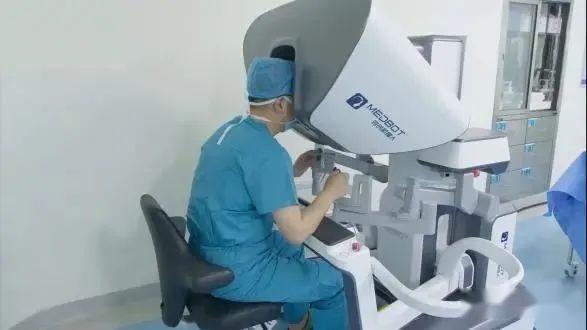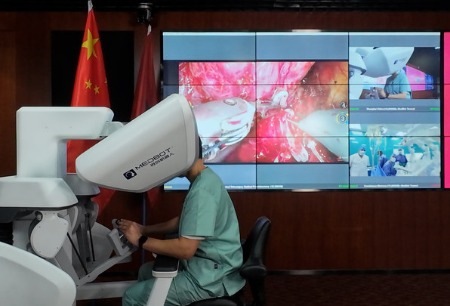China, Gansu - In recent years, with the increasing incidence of upper gastric cancer and adenocarcinoma of the esophagogastric junction (AEG), surgeries that preserve partial gastric function have become a focus in the field of surgery. Recently, the surgical team led by Director Nie Peng from the Department of Gastrointestinal Surgery at Gansu Wuwei Tumor Hospital successfully performed a robot-assisted laparoscopic Kamikawa anastomosis procedure (esophagogastric double muscular flap anastomosis) for a patient undergoing proximal gastrectomy, combining the advantages of the previous laparoscopic Kamikawa anastomosis with the Toumai® robotic surgical system. According to available information, this is the first clinical application of a domestically developed surgical robot for this procedure. Toumai® continues to challenge difficult surgeries, expand the application of new clinical procedures, and achieve pioneering clinical applications of domestically developed robots in urology, general surgery, thoracic surgery, and gynecological surgery, demonstrating its ability to provide patients with new treatment options beyond imported surgical robots and promoting the precise and intelligent development of medical care in China.

▲ Director Nie Peng operating the Toumai® robot during surgery
According to the introduction, for adenocarcinoma of the esophagogastric junction and upper gastric cancer, many hospitals adopt proximal gastrectomy to preserve partial gastric function and reduce nutritional complications. Although this surgery preserves some gastric function, it damages the structure of the esophagogastric junction, has a large trauma and slow recovery, and is prone to gastroesophageal reflux, causing reflux esophagitis and affecting the patient's quality of life. Director Nie Peng explained that the Kamikawa anastomosis procedure involves robot-assisted laparoscopic resection of the proximal stomach, followed by cutting the serosa and muscle layer in the anterior wall of the remaining stomach to completely free two muscular flaps. After laparoscopic manual suturing of the esophagogastric anastomosis, the two muscular flaps are sutured and covered on the lower segment of the esophagus and the surface of the anastomosis. This procedure effectively "reconstructs" the cardia and gastric fundus, preventing the reflux of acidic gastric fluid into the esophagus, reducing the incidence of reflux esophagitis, and ensuring nutrition. At the same time, due to the wrapping of the muscular flaps, the occurrence of anastomotic fistula is greatly reduced, effectively improving the postoperative quality of life for patients, especially for patients with early-stage esophagogastric junction and upper gastric cancer.
The patient in this surgery was diagnosed with cardia cancer and chronic atrophic gastritis. After careful evaluation and extensive discussion, Director Nie Peng's team decided to perform a robot-assisted laparoscopic radical proximal gastrectomy with esophagogastric double muscular flap anastomosis.
On the day of the surgery, with close cooperation from the anesthesiology department, Director Nie Peng's team successfully completed the surgery in less than 4 hours. After careful postoperative care in the hospital, the patient recovered well, and there were no symptoms of leakage or acid reflux at the anastomosis site. The patient and their family were very satisfied with the surgical treatment, expressing gratitude for being able to receive advanced domestic surgical robot treatment close to home and to benefit from the meticulous treatment and high-quality medical services provided by Director Nie Peng's team and the nursing team.
The hospital stated that by fully tapping into and leveraging the advantages of the Toumai® robotic surgical system, the surgical team was able to overcome the limitations of traditional surgical methods and provide patients with more precise, safe, and effective treatment options. Patients can better maintain nutritional intake and digestive function after surgery, which helps accelerate the recovery process and improve their quality of life. In addition, the mastery of this technology will lay a solid foundation for the further development and promotion of such surgeries, marking a new milestone in the minimally invasive surgical treatment of gastric cancer at Gansu Wuwei Tumor Hospital.
According to the hospital, since the first domestically developed Toumai® four-arm surgical robot system was clinically applied at Gansu Wuwei Tumor Hospital in February 2023, surgeons have successfully completed over 60 robot-assisted surgeries, including more than 30 cases of gastrointestinal tumor surgeries. During the surgeries, the three-dimensional stereoscopic view and highly flexible wrist-type surgical instruments provided by the Toumai® robot have helped the doctors overcome many disadvantages of traditional open surgery and laparoscopic surgery, successfully completing various difficult surgeries. In the field of gastric cancer surgery, the hospital keeps up with international trends, actively exploring and conducting various robot-assisted intracavitary gastrointestinal reconstruction surgeries. This innovative medical model not only provides patients with cutting-edge and effective treatment methods and more precise treatment plans but also significantly shortens the recovery time and helps them regain health as soon as possible.









 Hu ICP Bei No. 20013662 HGWA Bei No. 31011502015178
Hu ICP Bei No. 20013662 HGWA Bei No. 31011502015178 " are registered trademarks of Shanghai MicroPort Medical (Group) Co., Ltd.” . They have been authorized to be used by Shanghai Microport Medbot (Group) Co., Ltd., and no other party shall use such trademarks without prior written permission thereof.
" are registered trademarks of Shanghai MicroPort Medical (Group) Co., Ltd.” . They have been authorized to be used by Shanghai Microport Medbot (Group) Co., Ltd., and no other party shall use such trademarks without prior written permission thereof.
